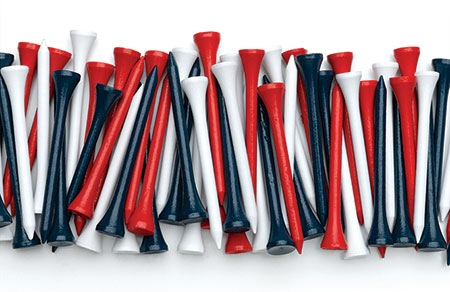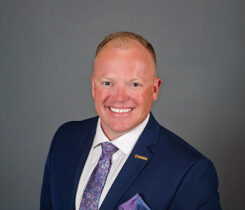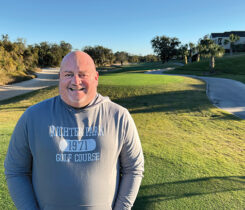Web Exclusive: More from the 2019 State of the Industry report part 2

Photo: AdShooter/Stock/Getty Images Plus/Getty Images
2019 was a year of many successes, multiple challenges and happily, a few near misses.
An inaccurately forecast hurricane saved a lot of superintendents some trouble (but not the unnecessary prep work), while floods and drought were common themes in this year’s report. The labor challenge? We had to laugh when Daniel Francis, president of the Cincinnati GCSA, said, “I’m not going to talk about labor. Everyone knows labor is a problem.”
For our 2019 State of the Industry report, sponsored by Nufarm, we once again embarked on a journey to learn what the golf season was like across the country. We talked to GCSAA chapter presidents and representatives to learn about regional weather, disease pressures, challenges and successes.
Below are additional reports to be added onto the 2019 State of the Industry report. To jump to a specific interview, click on their name below.
- Michigan: Jeff Sweet, CGCS
- Idaho: Josh Benson, CGCS
- Alabama: Lee Fillingim, CGCS
- Rhode Island: Mike Varkonyi, CGCS
- Connecticut: Paul Bonini, CGCS
- Oregon: Shane Hadwick, CGCS
Jeff Sweet, CGCS
President, Michigan GCSA
Vice President and Former Superintendent, Bucks Run Golf Club, Mt. Pleasant, Mich.
Generally speaking, how was the golf season in your region?
Pretty good. When the sun was shining, golfers were out, which is a positive sign for golf in the state. My colleagues at the Michigan Golf Course Association tell me rounds were on pace or up at most clubs compared to 2018. Overall, the state of Michigan’s golf industry is very positive.
How was the weather for your area this year?
Wet. Much of the state had a very wet spring that lasted into the beginning of June. The rain picked back up in September and continued through November. In central Michigan, we had over 20 inches of rain in October. That will probably set us up for another wet spring.
What was the disease pressure like in your area in 2019?
Moderate. Dollar spot was the main disease; anthracnose and summer patch were hit and miss. Due to the wet weather, Pythium was an issue on some courses and wetting agent usage declined. I would bet that many courses are looking at drainage improvements after this season.
What was the biggest challenge faced by your area this year?
The moisture. When the rain came, it always seemed to be measured in inches. We didn’t seem to have the light tenth of an inch of rain — it always appeared to be over an inch at a time.
Were there any notable success stories from your area/chapter this year?
Our chapter continues to notice more companies joining our Industry Partnership Program, an integrated, multidimensional marketing strategy that provides access to our members. These companies see the value in supporting and investing in our members. After all, Michigan comprises one of the world’s largest golf markets as it has the most public courses in the United States. There’s simply no better way for companies to communicate their products and services to Michigan’s golf industry than through the Industry Partnership Program. No matter what companies’ budgets or sales strategies are, they will receive a return on their investment. To ensure companies successfully market themselves to our members, we offer traditional magazine advertisements, along with a digital publication that contains clickable links. To communicate with our membership, we’re also turning more to digital communication and phone applications. And our social media audience is consistently growing, as our website had more than 5 million hits in 2019.
What are your expectations for 2020?
We will continue to provide value to our members through programs and services that enhance and promote our profession. I also think the golf industry in Michigan will continue to grow in 2020. I’m looking forward to a great year.
Josh Benson, CGCS
President, Idaho GCSA
Superintendent, Idaho Falls Country Club, Idaho Falls, Idaho
Generally speaking, how was the golf season in your region?
We had a slow start at my course, with six of the 18 greens having ice damage from a midwinter thaw and temperatures plummeting to single digits afterward. By the end of June, everything had recovered, and we had a very good summer.
How was the weather for your area this year?
Our weather started off rough with a midwinter thaw followed by a deep freeze. The weather in the summer ended up being great, while fall brought us an early October freeze. After the freeze, the fall ended with good golf weather, though.
What was the disease pressure like in your area in 2019?
Disease pressure on the east side of the state was very low. Superintendents just need to make sure they always get their snow mold applications down before the first big storm hits each fall.
What was the biggest challenge faced by your area this year?
Labor is our biggest challenge in this area. I have a great core group of guys who have been at the course for three or more years and that helps. We increased wages in 2019 and I was able to attract a few more applicants, but for the most part, it’s a continual struggle with the unemployment rate so low in the area.
Were there any notable success stories from your area/chapter this year?
Our spring meeting and trade show is big for our chapter. We get very good support from our allied members for the trade show, and attendance for the meeting is always good for this time of year because we bring in the top speakers in the industry. We also have our Boise Golf Expo silent auction, which has been a huge success, with members donating rounds from their courses to be auctioned off, while all the proceeds go back to the Idaho GCSA.
What are your expectations for 2020?
Our biggest goal is to have our BMP document completed for Idaho this year. This document will help superintendents in our state implement BMPs on their courses to help create the best environment possible. Most of these practices are already being used across Idaho.
Lee Fillingim, CGCS
President, Alabama GCSA
Superintendent, Anniston Country Club, Anniston, Ala.
Generally speaking, how was the golf season in your region?
Rounds seemed to be flat or about the same in 2019 as they were in 2018. However, daily fee course rounds actually were up when compared to 2018’s figures.
How was the weather for your area this year?
We experienced cool weather during the spring, which was also a little on the wet side. And then we had about a four-week drought from the end of May into July. Afterward, rain throughout July kept water in the ponds, while a drought occurred from August through October, a month in which record highs, 100 degrees, were recorded.
What was the disease pressure like in your area in 2019?
Because of the drought conditions, disease pressure was low, as we could manage water on the greens.
What was the biggest challenge faced by your area this year?
The drought was probably the biggest challenge, along with developing some “think outside of the box” ideas for staffing in order to meet demands on the course. Multiple part-time hires were used to mow the course.
Were there any notable success stories from your area/chapter this year?
For us superintendents in Alabama, it seemed that we communicated more this year, whether through actual in-person conversations or using texts, Twitter and social media.
What are your expectations for 2020?
2020 will require us to think outside the box to increase rounds and memberships. The key will be to find ways to get families out on the course. Par-three challenges, cookouts on the fairway and playing four holes followed by lunch or dinner are just some ideas that may help make golf more fun for the whole family. In addition, we’ll need to focus on the labor force and find different ways to meet people’s busy schedules in this day and age.
Mike Varkonyi, CGCS
President, Rhode Island GCSA
Superintendent, Louisquisset Golf Club, North Providence, R.I.
Generally speaking, how was the golf season in your region?
The golf season in our area was pretty good last year, especially when compared to the 2018 season, which was cut short and limited because of several long-lasting rain events. Play seemed to be steady for the most part. Overall, numbers were up from 2018, but it’s hard to determine if that is due only to better weather — drier — or golfers playing more. Golfers tend to follow weather reports. If the forecast midweek is for inclement weather on Saturday and Sunday, they’ll make other plans. And if the weekend weather changes, most will stick with those other plans.
How was the weather for your area this year?
The spring started out a bit wet but became a little cooler than average, yet it was still manageable. The summer had a few stressful points, but none that were too extended. The fall, meanwhile, was nice and good for growing turf, as it was a little cooler than normal, but again, manageable.
What was the disease pressure like in your area in 2019?
Disease pressure in our area was no more than moderate — with maybe a couple spikes because of some short hot and humid conditions. The spring was probably the most pressure-packed time of the year as the turf was wet from the early rains.
What was the biggest challenge faced by your area this year?
A popular discussion was about finding and keeping quality staff. With unemployment numbers at record lows, there aren’t the same amount of people seeking seasonal positions. Many superintendents in our area that I have talked to are always looking for at least one or two more individuals. Many clubs have scaled some of their staffing numbers back to stay within budget numbers that seem to remain level or are even dropping in some cases. It is a fine line to balance, as many states are increasing minimum wages. Clubs have had to follow suit, raising wages even though they were paying more than minimum wage before. They have pared down their staffs due to that increase. If a club has 15 hourly employees and they raise the pay by $1 an hour, that’s a $15-an-hour total, leading the club to possibly eliminate a position.
Were there any notable success stories from your area/chapter this year?
A notable success story for our area began last year and will hopefully come to fruition this spring: instituting a National Golf Day in Rhode Island. Our association, along with the RI Golf Association, club managers and owners’ associations, is working collectively to have National Golf Day approved by the state legislature.
What are your expectations for 2020?
This year, the biggest event in Rhode Island will be the 2020 U.S. Senior Open, which will be held at Newport Country Club. Our entire association will be helping where and when they can. Volunteers already are signing up and are being organized. We’re a small state and a small association, but we’re also a very close-knit one. We all want to see Chris Coen (superintendent at Newport Country Club) and his staff shine.
Paul Bonini, CGCS
President, Connecticut Association of GCS (CAGCS)
Superintendent, Watertown Golf Club, Watertown, Conn.
Generally speaking, how was the golf season in your region?
Last year, Connecticut’s golf season was average for the most part as a majority of golf clubs recorded the usual amount of play. We had a slow start to the season with a cold, late winter/early spring, but the number of rounds rebounded by Memorial Day.
How was the weather for your area this year?
The weather for our area was a usual roller coaster. A mild winter led to a cooler-than-normal spring. We jumped right from a cool spring to a warm summer and were then off and running. I think it was a typical New England summer and a nice start to the fall, but we ended with a wet fall/early winter, which limited end-of-season rounds. And, at the end of the year, the weather was not what we asked for, as we had several snow and thaw events.
What was the disease pressure like in your area in 2019?
Our disease pressure has been pretty consistent over the past few summers. The usage of so much social media — along with using additional models on university websites and having knowledgeable sales reps — helps superintendents know what to look out for, while also learning what other superintendents have done to successfully manage their courses’ diseases.
What was the biggest challenge faced by your area this year?
I think our biggest challenge in the area is not even related to turf management, but rather economics. Over the years, so many clubs and courses have been required to run on so much less and still produce a great product. But unfortunately, due to economics, a lot of clubs struggle to keep up. This is another area in which talking with other superintendents, while also sharing ideas of bending the dollar a little more, is very helpful.
Were there any notable success stories from your area/chapter this year?
The CAGCS had a few highlights in 2019. Most notably, a member of CAGCS, Peter Gorman, was awarded the Excellence in Government Affairs Award from the GCSAA. He was an important part of the state’s BMP development, as well as a member of the Water Planning Council, and he helped develop the state water plan. CAGCS is happy and proud to have Pete as a member. We also said goodbye to our chapter executive, Mary Jo Kennedy, who retired after 20 years of service. We wish all the best to her and her husband, Les Kennedy, CGCS, with their retirement plans.
What are your expectations for 2020?
My expectations for 2020 are to continue the tradition of CAGCS through my term as president of the association. So much has already been accomplished by past presidents and members of the association throughout the years. We have worked hard with local and state agencies to develop a great mutual relationship, and our members are some of the strongest and most dedicated people I have met. With all of this in mind, I expect great things for CAGCS in 2020 as we continue to improve.
Shane Hadwick, CGCS
President, Oregon GCSA
Superintendent, Orchard Hills Golf and Country Club, Washougal, Wash.
Generally speaking, how was the golf season in your region?
Overall, we seemed to have a successful golf season in this region. From what I’ve heard, rounds, memberships and budgets were steady if not climbing in 2019. With our industry being heavily tied to the economy, many courses have seen positive growth in the years since the recession. I don’t think that Tiger Woods’s comeback and win at Augusta hurt golf courses too much, either.
How was the weather for your area this year?
The weather was conducive for golf in the area. Our summer was milder than the last few years — closer to average. We had fewer rainy days than normal in the spring and fall, but we’re hoping for a good snowpack in the mountains now.
What was the disease pressure like in your area in 2019?
The disease pressure in the region matched up with the weather in 2019. In the wetter months, we had our typical microdochium/fusarium pressure in areas without snow cover, and, because of the cooler summer, anthracnose pressure seemed to be lighter than it was in past warmer years.
What was the biggest challenge faced by your area this year?
I believe one of the biggest challenges that courses faced in 2019 was hiring and retaining qualified and experienced employees. Fewer turf programs in the region, immigration restrictions and rising minimum wages have had an impact on courses. Couple that with the regional growth we’ve had and the opportunities in the trade job market, it’s tough for superintendents to compete for employees.
Were there any notable success stories from your area/chapter this year?
Last spring, our chapter, the Oregon GCSA and the Western Washington GCSA chapter teamed up for a service project in Lakewood, Wash. We spent the day at American Lakes Veterans Golf Course, working alongside some amazing veteran volunteers who maintain the course daily. The OGSCA also continued its financial support of the turf program at Oregon State University through a pledge of $15,000 annually to the Oregon Turfgrass Foundation.
What are your expectations for 2020?
This year, our chapter is excited to complete the third edition of our Environmental Stewardship Guidelines and help our membership adopt these BMPs at their own facilities. We also hope to continue to work with the WWGCSA on a service project in Oregon.












